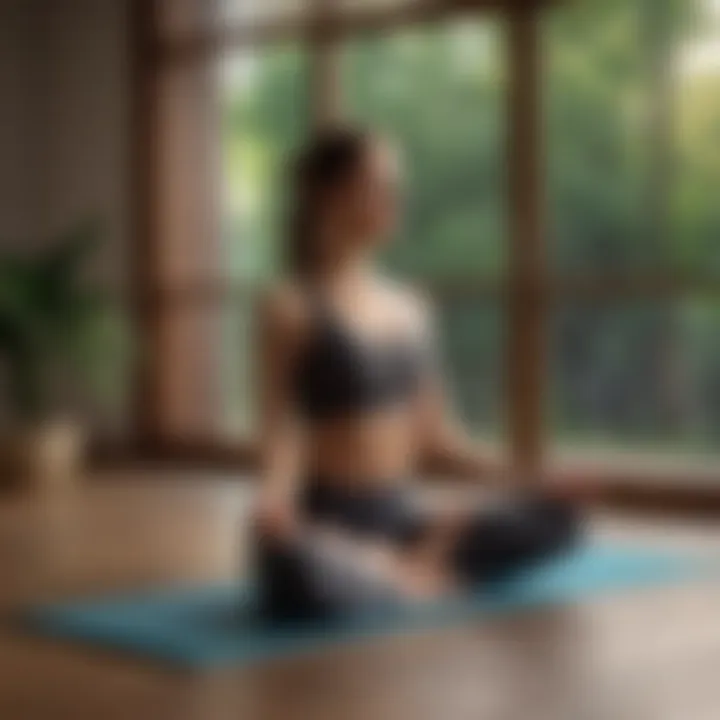Discover the Best Yoga Apps for Your Practice


Intro
In recent years, the appeal of yoga has surged dramatically. As more people seek holistic approaches to fitness and wellness, yoga stands out for its ability to unite physical, mental, and emotional health. With hectic lifestyles, individuals increasingly turn to technology for wellness solutions. This evolution has led to the rise of yoga apps, providing users with the convenience of practicing yoga anywhere and at any time.
The landscape of yoga applications is diverse, with offerings that cater to various skill levels and preferences. Some apps offer guided sessions led by renowned instructors, while others focus on community engagement and interaction. Assessing these applications requires a nuanced understanding of their features, usability, and overall value to users.
This review aims to present an informed selection of the best yoga apps available today. Through thorough evaluation, we will analyze their key components and user experiences, enabling readers to make well-considered choices for advancing their yoga journeys.
Key Trends
As the yoga community continues to evolve, understanding recent trends helps to illuminate its direction. Here are some notable trends shaping the yoga app landscape:
- Personalization: Modern yoga apps are increasingly tailored to individual user needs. They consider factors such as experience level, fitness goals, and personal preferences in their offerings.
- Integration of Technology: Many apps now incorporate useful technology features like virtual reality sessions and live-streamed classes, enhancing the practice experience.
- Community Focus: Engaging with like-minded individuals has become a priority, leading to features that foster community and connection within apps.
- Holistic Wellness: Beyond physical poses, apps are embracing a more holistic view of wellness, including mindfulness meditation and nutritional guidance.
Understanding these trends is important as they influence which app features resonate most with users.
User Experience Insights
User experience plays a crucial role in the effectiveness of a yoga app. The ease of navigation, quality of video content, and support resources can vary widely. Here are essential elements that influence user satisfaction:
- Intuitive Interface: A well-designed app should facilitate easy navigation. Users should be able to locate classes and features with minimal effort.
- Quality of Sessions: Video and audio quality are critical for an engaging practice. Users value clear instructions and professional production quality.
- Progress Tracking: A robust tracking system allows users to monitor their development over time, fostering motivation and commitment.
- Diversity in Offerings: A wide range of styles and levels can cater to a larger audience, making apps appealing to beginners and seasoned practitioners alike.
"A well-executed yoga app can transform an individual's practice, making yoga accessible and enjoyable from anywhere."
Epilogue
This overview sets the stage for a deeper discussion on specific yoga applications, their features, and user experiences. By analyzing these aspects, individuals can select the best apps that align with their unique wellness journeys.
Prelims to Yoga Apps
The incorporation of technology into personal wellness routines has created a significant shift in how people engage in practices like yoga. As millions discover the benefits of yoga for both physical well-being and mental wellness, yoga apps have emerged as essential tools in this journey. These applications offer flexibility, accessibility, and a wide variety of classes at almost any time, making yoga more accessible than ever.
The Role of Technology in Wellness
Technology has changed the landscape of wellness, allowing practices like yoga to transcend geographical boundaries. The proliferation of smartphones and tablets has enabled users to bring their practice into their homes, or wherever they might be.
Having access to yoga classes online allows for convenience and a personalized approach. Users can choose sessions that fit their time schedules and skill levels. Moreover, with features such as instructional videos and music integration, technology enriches the yoga experience and can facilitate deeper engagement.
Why Choose Yoga Apps?
Opting for yoga apps comes with several noteworthy benefits. They cater to a vast range of preferences and requirements, appealing particularly to those who might feel intimidated by traditional studio settings. Here are some compelling reasons:
- Accessibility: Users can practice yoga anytime and anywhere without the need for physical presence in a studio.
- Variety: These apps often offer a plethora of classes, from beginner to advanced levels, along with varying styles including Vinyasa, Hatha, and Restorative yoga.
- Cost-effective: Many yoga apps provide free content or affordable subscription models compared to regular classes at studios.
- Personalization: Users can select classes that align with their personal goals, whether it's flexibility, strength, or mindfulness.
"Yoga apps are revolutionizing how people connect with their bodies and minds, regardless of their location or fitness level."
In summary, these elements establish the importance of yoga apps in modern wellness regimens. As we delve deeper into specific features, user experiences, and recommendations in the following sections, we will further underscore how these applications can optimize one's yoga practice and enhance overall health.
Features to Consider in a Yoga App
The choice of a yoga app can greatly influence a user's experience and outcomes. It is essential to consider various features that enhance usability and effectiveness. Understanding these features allows individuals to select applications that align with their personal practice and lifestyle. A well-structured app contributes to a more engaging and productive yoga journey, as technology can sometimes complicate rather than facilitate wellness practices.
User Interface and Experience
A user-friendly interface is crucial in any app. For yoga applications, this means clear navigation, appealing visuals, and easy access to content. Users appreciate a clean layout that allows them to find classes quickly without unnecessary distractions. The experience should feel intuitive; from browsing through various classes to tracking their progress, users should not encounter confusion or frustration. A positive user experience can foster consistent practice, encouraging users to return for more.
Variety of Classes Offered
Diverse class offerings are pivotal in a yoga app. Users come with different levels of expertise, preferences, and goals. An app should cater to beginners, intermediates, and experts alike, providing a variety of yoga styles such as Hatha, Vinyasa, or Yin. Class durations should also vary to accommodate different schedules—from quick ten-minute sessions to more extensive, hour-long practices. This variety not only keeps users engaged but also aids in overall skill development and physical fitness.


Customization and Personalization
Customization features make an app more relevant to individual users. This can include options for selecting the level of difficulty, specific goals like stress relief or strength building, and preferences for class length. Personalized recommendations based on past activities also enhance the experience. When users feel that the content is tailored to their needs, they are more likely to stay motivated and committed to their yoga practice.
Integration with Wearable Devices
Integrating with wearable devices adds another layer of functionality to yoga apps. This allows users to monitor their heart rates, calories burned, and even meditation insights in real time. Such integration can enhance motivation and accountability. By syncing with devices like Fitbit or Apple Watch, users gain access to a more comprehensive view of their progress, allowing adjustments to their practice as needed. This technological support can greatly enrich the user's journey in yoga, providing deeper insights and reinforcing healthy habits.
Proper selection of a yoga app requires a clear understanding of its features to achieve desired results.
In summary, considering the user interface, variety of classes, customization options, and integration capabilities can lead to a more fulfilling yoga experience. These elements play a vital role in whether a user will enjoy and benefit from their yoga practice. Users should evaluate these features carefully when choosing an app, ensuring it meets their personal needs and preferences.
Top Yoga Apps Overview
In the contemporary wellness landscape, yoga apps play a substantial role. They integrate technology into physical fitness and mental wellness, offering users a flexible way to engage with yoga practices. The overview of the top yoga apps is essential to navigate through the myriad of options available. Each application provides unique benefits based on features, user friendliness, and adaptability to individual needs.
Focusing on the characteristics of top yoga apps can help users make informed decisions. Elements to consider include the variety of classes, customization options, and integration with other devices. Each app caters to specific demographics and needs, ensuring a personalized experience.
App One: Name and Features
Unique Selling Propositions
One prominent app is Yoga Studio. This app stands out for its extensive library of classes and offers a structured learning experience for users of all levels. One of the key characteristics is its ability to provide predefined classes but also allows users to create their own. This versatility makes it beneficial to explore various styles of yoga
Additionally, it offers a meditation section, which adds extra value for users seeking a holistic approach to wellness. The unique feature of this app is its high-quality video demonstrations. These visuals can greatly enhance a user's practice and understanding of posture alignment.
Target Audience
Yoga Studio targets individuals ranging from beginners to advanced practitioners. It is especially suitable for people who like structured guidance yet also prefer practicing at their own pace. This broad appeal is a distinct advantage. The app encourages consistency by providing diverse options tailored for both physical and mental aspects of yoga.
Pricing and Subscription Options
Yoga Studio offers a subscription model that is generally considered affordable. There is a free trial available, which allows users to test features before committing. Once the trial is over, users can decide on the monthly or yearly subscription plans. This flexibility is attractive for users who may want to engage with the app on a temporary basis before investing long-term.
App Two: Name and Features
Unique Selling Propositions
Down Dog is another notable app that emphasizes intensity and adaptability of workouts. It is popular due to its customizable sequences, allowing users to adjust difficulty and length according to their schedules. Another key characteristic is its focus on different styles like Hatha, Vinyasa, and others, making it appealing for a diverse group of yoga enthusiasts.
A unique element of Down Dog is its audio cues, which guide users through each posture. This feature can particularly benefit those who prefer listening over watching.
Target Audience
Down Dog caters to a wide audience, from newcomers to seasoned practitioners. The flexibility of customization makes it attractive to users who might be deterred by more rigid formats. Those who can integrate yoga into their busy lives welcome the ability to adjust class length and intensity.
Pricing and Subscription Options
With an initial free access period, Down Dog also offers subscriptions at competitive rates. Users can choose between monthly or annual subscriptions. This pricing strategy aids individuals on a budget, making it accessible to a larger community.
App Three: Name and Features
Unique Selling Propositions
Another noteworthy option is Glo. This app offers a comprehensive approach by integrating different types of classes, including yoga, meditation, and fitness. One major selling proposition is its connection to professional instructors. This feature lends credibility to the content and enhances user trust in the training provided.
Furthermore, Glo places a strong emphasis on community. Users can engage in forums and discussions, which promotes social interaction around wellness.
Target Audience


Glo appeals to people looking for a complete wellness package. It targets users who value connecting with others during their yoga journeys. This communal aspect can enhance motivation and enjoyment.
Pricing and Subscription Options
Glo has a subscription model that is competitively priced. Users can also try the app for free initially, which makes it easy to assess if it aligns with their needs. The annual subscription option provides savings for those who commit long-term.
App Four: Name and Features
Unique Selling Propositions
Asana Rebel focuses on the fitness aspect of yoga. Its unique selling point is to merge traditional yoga with high-intensity workouts. This app is designed to attract users interested in a more physically demanding experience while still promoting wellness.
The app provides a plethora of different workouts, emphasizing flexibility and strength. The focus on fitness can attract those who may not identify as traditional yoga practitioners yet want benefits that yoga provides.
Target Audience
Asana Rebel targets a younger audience or fitness enthusiasts who wish to incorporate yoga into their workout routines. This group may benefit from the blended approach of yoga and high-intensity workouts, providing alternatives to standard fitness regimens.
Pricing and Subscription Options
Asana Rebel has various pricing options, including monthly and yearly plans. The initial trial period allows potential users to evaluate if its blended approach suits their fitness goals before full commitment.
App Five: Name and Features
Unique Selling Propositions
Lastly, the app called Insight Timer is remarkable for its focus on mindfulness and meditation. While not a traditional yoga app, it can enhance any yoga practice. Its unique selling point is the vast library of free meditations, which can complement yoga sessions perfectly, enhancing mental clarity.
Moreover, it includes a community feature that allows users to connect, share experiences, and support each other in their wellness journeys.
Target Audience
Insight Timer is ideal for users who prioritize meditation and mindfulness as part of their journey, particularly those seeking supplementary tools to support their yoga practice. This aspect makes it distinctively useful for a wide range of practitioners.
Pricing and Subscription Options
The app is largely free, with optional premium features. This makes it accessible for users who want to explore mindfulness without a financial commitment, enhancing its appeal to those just starting on their wellness journey.
In summary, the evaluation of these top apps provides insight into how they each serve different user needs. By recognizing their unique features, target audiences, and pricing structures, readers gain a clearer path to selecting an app that resonates with their personal yoga practices.
User Experience and Ratings
User experience and ratings hold significant value in assessing yoga applications. The effectiveness of a yoga app often hinges on how users interact with it. A well-designed app enhances user satisfaction, leading to improved yoga practice. The ability to navigate effortlessly, access classes, and personalize routines contributes to overall enjoyment. Thus, understanding user experiences and feedback can guide potential users in making informed decisions.
User Reviews and Feedback
User reviews are a vital component of evaluating yoga apps. They provide insights into actual experiences reported by those who have used the application. Often, users highlight specific features that they find beneficial or frustrating. For example, an app might be praised for its vast library of classes but criticized for technical issues or lack of customer support.
Feedback mechanisms in apps also allow users to communicate directly, which can lead to improvements over time. This interaction not only benefits future users but also creates a sense of community around the practice of yoga. Reading about others' experiences can help new users identify what to expect and what adjustments they may need to make during their practice.
Comparison of App Ratings
Examining app ratings can guide users in choosing the right yoga app. Ratings typically reflect overall user satisfaction and offer a snapshot of the app's strengths and weaknesses. Many users rely on platforms like Google Play Store or Apple App Store to compare these ratings.
- High Ratings: Generally indicate a positive reception but should be interpreted with caution. Some apps may accumulate ratings through promotional tactics.
- Diverse Ratings: A mixture of high and low ratings can signal that while some users thrive with the app, others may face issues.
App ratings reveal valuable information, but it is essential to read the accompanying reviews for context.
When analyzing ratings, consider the total number of reviews. A small number of reviews can be misleading. A well-rated app with only a few reviews might not offer reliability compared to one with solid ratings amassed across many users. Therefore, potential users should explore both ratings and detailed feedback for a rounded understanding.


Challenges and Limitations of Yoga Apps
In the realm of technology-driven wellness, while yoga apps provide immense accessibility and convenience, they do come with certain challenges and limitations. Understanding these constraints is crucial for users who seek to maximize the benefits of their yoga journey. Without recognizing these issues, individuals may face setbacks in their practice, potentially undermining their overall wellness goals. Let’s explore these limitations in detail.
Physical Limitations for Users
Yoga apps often attract a broad audience, spanning all fitness levels and experience. However, they may not always account for individual physical limitations. Users may have different requirements due to health issues, prior injuries, or unique body structures. Online yoga videos often lack the interactive element that in-person classes provide.
Effective yoga practice requires feedback on posture and alignment. Without this guidance, users may unknowingly perform poses incorrectly, which could lead to injuries. For example, beginners might struggle with advanced poses or transitions that require a certain level of strength and flexibility.
Moreover, even well-structured apps may not include modifications or alternatives for specific poses, making it challenging for those with physical restrictions. Users with limitations might find themselves frustrated when they cannot replicate the movements shown in videos.
It’s advisable for apps to include options that address various physical capabilities. Wider representation might help users feel informed and accommodated, promoting a safer and more effective experience.
Lack of Personalized Guidance
Another significant challenge with yoga apps is the lack of personalized guidance. While many apps offer a variety of classes and styles, the one-size-fits-all approach may not suit every user's needs. The absence of individualized attention can impede progress and lead to feelings of isolation.
Users often benefit from the insights of a live instructor. These professionals can tailor recommendations based on a person's specific needs or goals. In contrast, yoga apps typically rely on pre-recorded videos, which do not take real-time feedback into account.
Considerations such as alignment, breathing, and adaptability to each student's body are often overlooked. For those serious about developing their practice, this can become a frustrating barrier. A lack of personalized feedback may also hinder motivation, as users might feel disconnected from their progress.
In summary, while yoga apps offer substantial benefits for accessibility and variety, one must consider the physical limitations of users and the absence of personalized guidance. People should weigh these challenges against their wellness goals and decide if a yoga app is right for them.
Future Trends in Yoga Apps
The landscape of yoga application development is in continual evolution. With a growing interest in digital wellness solutions, understanding the future trends is crucial for app developers and users alike. These trends will shape how yoga is practiced, its accessibility, and how it integrates with users' daily lives. Keeping up with these changes can enhance the benefits derived from yoga practices, offering new possibilities for practitioners.
Emerging Technologies in Yoga Practice
Emerging technologies are significantly influencing the way individuals engage with yoga applications. Institutions, developers, and users must adapt with the rapidly developing tech landscape. Here are some key technologies affecting yoga practices:
- Virtual Reality (VR): VR creates immersive experiences, enabling users to practice yoga in a variety of simulated environments. This makes the practice more engaging and helps to replicate real-life settings like beaches or mountains.
- Augmented Reality (AR): AR can enhance instructional content by overlaying visual guidance on the practitioner's environment. This technology assists users in achieving proper postures by providing real-time feedback.
- Artificial Intelligence (AI): AI can be used to analyze user performance and provide tailored recommendations or adjustments, making personal guidance more accessible. Smart algorithms can adapt routines based on user preferences and past performance.
- Wearable Technology: Devices such as smartwatches and fitness trackers provide biometric data that can enhance the yoga experience. Integration with apps can help track heart rate, calories burned, and even mindfulness levels, allowing users to monitor their progress.
These technologies are not just gimmicks; they promise to bridge the gap between traditional practices and modern demands. Incorporating technology can motivate users by providing personalized, engaging experiences, ultimately enhancing their practice.
Shifts in User Preferences
As the market for yoga apps expands, user preferences are also evolving. It is evident that different demographics are influencing how applications are designed and marketed. Here are some notable shifts:
- On-Demand Classes: Many users now prefer on-demand content, allowing them to practice at their own convenience. Flexibility in scheduling leads to a better user experience, as people have varied lifestyles.
- Focus on Mental Wellness: Users are increasingly interested in how yoga can benefit mental health. Apps providing meditation, mindfulness, and stress-relief techniques are gaining popularity, marrying physical practice with emotional well-being.
- Community Engagement: Users seek ways to connect with other practitioners, even in a virtual space. Features facilitating community interactions, such as discussion boards or live classes, are becoming essential in user acquisition and retention.
- Customized Programs: The desire for tailored programs is strong. Users often look for apps that can adapt to their unique fitness levels, goals, and preferences, moving away from one-size-fits-all approaches.
Culmination and Recommendations
In conducting a thorough review of yoga apps, it becomes clear that the significance of these digital tools lies in their capacity to enhance the practice of yoga for individuals of various levels. The conclusion drawn from this analysis emphasizes the importance of understanding the unique offerings of each app to select one that aligns seamlessly with personal goals and preferences.
Benefits of Using Yoga Apps
Yoga apps provide an accessible platform for practitioners to engage in a disciplined practice, regardless of their location. They eliminate barriers to entry, allowing users to practice at their convenience. Moreover, the flexibility of these apps supports an environment where users can experiment with different styles and instructors, which is invaluable in developing a well-rounded practice.
Considerations for Choosing the Right App
When evaluating yoga apps, certain elements require careful consideration. Users should look for features such as a variety of classes, customization options, and user-friendly interfaces. Ratings and user reviews also serve as critical indicators of an app's efficacy and user satisfaction. Furthermore, attention should be granted to pricing models, as subscriptions can range from free offerings to premium services with additional features.
"Choosing the right yoga app can transform your practice by tailoring it to your individual needs and progression."
In summary, selecting the appropriate yoga app can significantly affect one’s practice journey and overall wellness. As individuals embark on their search, it is crucial to weigh all these factors to make an informed choice that nourishes both the body and mind.
Final Thoughts on Effective Apps
The landscape of yoga apps has matured, offering a diverse collection of options that meet the varying demands of users today. An effective yoga app goes beyond mere video classes. It integrates community features, offers guidance for alignment, and promotes mindfulness, creating an immersive experience. An accomplished app fosters motivation through structured programs and challenges, catering to both beginners and seasoned practitioners.
Tailored Approaches for All Levels
An essential aspect of effective yoga apps is their ability to cater to a wide range of skill levels. Newcomers can benefit from beginner-friendly classes, while advanced users can delve into intricate techniques and specialized sessions. Furthermore, integrating feedback mechanisms can enhance learning by allowing users to track their progress and adjust their routines as needed.
Where to Start Your Yoga Journey
Starting a yoga journey with an app involves a few key steps. The first step is to identify personal preferences regarding style and goals. Preferences can vary from physical fitness to mental tranquility. Once this is established, explore the features of various apps, focusing on user interface and available classes.
Recommendations for Beginners
For those new to yoga, it is often beneficial to begin with apps that offer instructional videos alongside clear explanations of poses. Look for tutorials that explain the foundations and emphasize safety during practice. Programs which incorporate guided meditation and breathwork can also enhance the initial experience.
Exploring Different Options
After familiarizing with a particular app, consider supplementing the practice with another app to diversify the routine. Many users find joy in trying out various classes, instructors, and teaching styles. Finalizing on a few resources can help solidify a consistent practice and foster growth.



